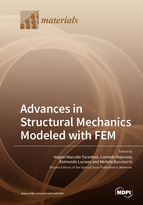Advances in Structural Mechanics Modeled with FEM
A special issue of Materials (ISSN 1996-1944). This special issue belongs to the section "Materials Simulation and Design".
Deadline for manuscript submissions: closed (2 February 2021) | Viewed by 37684
Special Issue Editors
Interests: viscoelasticity; fracture mechanics and dynamic propagation of cracks; bifurcation theory, nonlinear dynamics, and chaos; piezoelasticity and magnetoelasticity; contact problems; equilibrium, bifurcation, and stability in finite elasticity; fiber-reinforced concretes and earthquake engineering
Special Issues, Collections and Topics in MDPI journals
Interests: dynamic stability of structural systems; thermo-hydro-mechanical constitutive behavior of cementitious materials at high temperatures; coupled multi-physics formulations for multi-phase, porous media in unsaturated regime; high-performance concrete characterization and modeling; large strain formulation; plasticity of building materials
Special Issues, Collections and Topics in MDPI journals
Interests: computational mechanics of structures and of materials and specifically unilateral problems; computational analysis of masonry structures; computational mechanics of composite materials; finite element method; computational micromechanics; nonlinear and non-local theories
Special Issues, Collections and Topics in MDPI journals
Interests: finite element methods; structural mechanics; plates and beams; numerical analysis; laminated composites; multiphase composites; innovative composite materials; functionally graded materials; carbon nanotubes; non-local theories
Special Issues, Collections and Topics in MDPI journals
Special Issue Information
Dear Colleagues,
It is well-known that many structural and physical problems cannot be solved by analytical approaches. Such problems require the development of numerical methods to get approximate but accurate solutions. The Finite Element Method (FEM) represents one of the most typical methodologies that can be used to achieve this aim, due to its simple implementation, easy adaptability, and very good accuracy. For these reasons, the FEM is a widespread technique which is employed in many engineering fields, such as civil, mechanical, and aerospace engineering.
The large-scale deployment of powerful computers and the consequent recent improvement of the computational resources have provided the tools to develop numerical approaches that are able to solve more complex structural systems characterized by peculiar mechanical configurations. Laminated or multi-phase composites, structures made of innovative materials, and nanostructures are just some examples of applications that are commonly and accurately solved by FEM. Analogously, the same numerical approaches can be employed to validate the results of experimental tests.
The main aim of this Special Issue is to collect numerical investigations focused on the use of the Finite Element Method. Authors are encouraged to submit innovative applications solved by means of the FEM. The structural systems analyzed in the researches should be also well-described from the mechanical point of view, and particular emphasis may be given to advanced materials.
The topics of interest include, but are not limited to
- Numerical analyses of structural systems by FEM;
- Investigations of the mechanical behaviors of beams, plates, and shells;
- Numerical studies of laminated composite systems;
- Advanced and innovative composites;
- Accuracy and convergence analyses of FEM or Finite Element-based methods;
- Numerical approaches for the mechanical analysis of nanostructures;
- FEM applications for elasticity problems;
- Linear and nonlinear behaviors of structures;
- Mechanical characterization of innovative constituents;
- Validation of experimental procedures.
Prof. Dr. Angelo Marcello Tarantino
Prof. Dr. Carmelo Majorana
Prof. Dr. Raimondo Luciano
Dr. Michele Bacciocchi
Collection Editors
Manuscript Submission Information
Manuscripts should be submitted online at www.mdpi.com by registering and logging in to this website. Once you are registered, click here to go to the submission form. Manuscripts can be submitted until the deadline. All submissions that pass pre-check are peer-reviewed. Accepted papers will be published continuously in the journal (as soon as accepted) and will be listed together on the special issue website. Research articles, review articles as well as short communications are invited. For planned papers, a title and short abstract (about 100 words) can be sent to the Editorial Office for announcement on this website.
Submitted manuscripts should not have been published previously, nor be under consideration for publication elsewhere (except conference proceedings papers). All manuscripts are thoroughly refereed through a single-blind peer-review process. A guide for authors and other relevant information for submission of manuscripts is available on the Instructions for Authors page. Materials is an international peer-reviewed open access semimonthly journal published by MDPI.
Please visit the Instructions for Authors page before submitting a manuscript. The Article Processing Charge (APC) for publication in this open access journal is 2600 CHF (Swiss Francs). Submitted papers should be well formatted and use good English. Authors may use MDPI's English editing service prior to publication or during author revisions.









